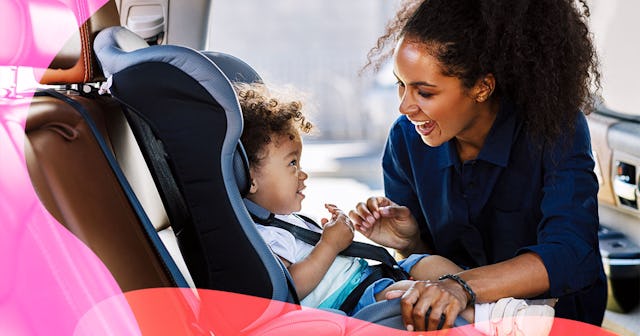When Car Seat Battles And Bodily Autonomy Collide

Recently, my 20-month-old toddler decided that she didn’t want to be buckled into her car seat.
After a year and a half of loving car rides, one day she just was done with it. I would plop her into the bucket of the seat, but before I could snap together the starfish of buckles over her chest, she would squirm away and stand up, giving me a sly look and a giggle.
Her pediatrician warned me a while ago that this was a common developmental milestone and suggested that if I needed to get her to sit down, I push on her hips as that was a point where I couldn’t hurt her. So I took a breath, flipped her around, and held her down with one hand while I tried to pull the straps together with the other.
Instantly my baby’s attitude changed from willful and fussy to panicked and desperate. She pushed back against me with the full force that her little body was capable of. She scratched and bit me like her life was hanging in the balance and began to emit deep, choking sobs. By the time I was able to tighten the belt, she was inconsolable.
I was at a loss. How many times had I buckled her in before? A thousand? Couldn’t she understand, on some level, there was nothing to be frightened of and that getting in her carseat was a non-negotiable step necessary for her safety?
I had hoped that this was a one-time thing, but the next time I tried to settle her in the car, she clung to me and wouldn’t let go. The more I insisted that she sit down and let me buckle her, the more she resisted it until she began to meltdown when we even approached the car.
Tang Ming Tung/Getty
One afternoon, as I picked her up from preschool, I opened the back door of the car and set her down, and she immediately scrambled to stand up in the seat. I braced myself for the struggle — it was the Friday of a very long week, I was physically exhausted, the traffic was only getting worse, and I wanted nothing more than to be home — but I just couldn’t fight her anymore.
My husband and I joke about how our daughter is such a physical creature; he and I center our work and our identities on books and articles and conversation and games, but she experiences the world by running and climbing and touching and pushing and pulling. She is in love with her body and all of the things it can do, and I was taking that away from her.
So I took a deep breath (through the mask that I was so eager to take off) and waited. My daughter eyed me warily, ready to claw at me and shriek, but I just stood next to her. It might have taken 10 minutes, but she eventually turned around and sat down herself.
In trying to figure out what parenting means to me, I’ve made the commitment to my daughter and to myself that her sense of ownership over her body comes before everything else except for her immediate safety. It’s a tough lesson to teach when I’m struggling to get out the door so that I can drop her off and get to work on time or when it’s raining and I’m on my last nerve or when someone else is waiting for me to close the car door so that they can take the parking space next to me.
But it’s a lesson that I want her to remember years from now when a romantic partner is asking her to do something that she doesn’t want to do or when a doctor is pressuring her into a course of treatment that doesn’t feel right or when someone has a problem with how she looks or what she wears.
Now when we get in the car, she still often decides that she’s not ready to sit down. I build in a few extra minutes when I know we need to be somewhere on time, and I use the opportunity to read a few tweets, take a few sips of water, or just center myself. I’ll offer her a toy or a snack if she will sit down, and more often than not, we’re ready to go in under five minutes — a price that I’m happy to pay for my child to know that her body is hers alone.